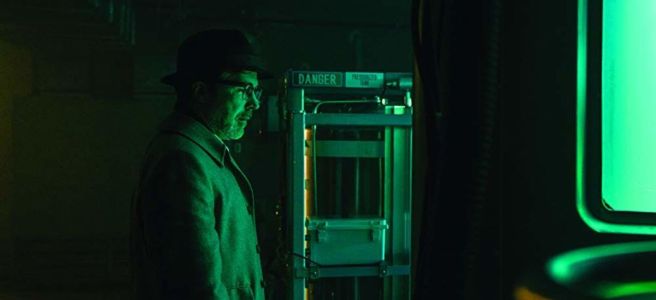As he wraps up his bracingly well-informed commentary on the season finale of History’s Project Blue Book, Kevin Randle remarks the vocal loathing some ufophiles have expressed for the series, confessing that he doesn’t “understand their hostility. Project Blue Book is not a documentary but a drama that has a historical background and a loose, very loose, interpretation of some of the sightings that are found in the Blue Book files.” For my part, I’ve made clear I find the series a lost opportunity, either to accurately represent (if dramatize) the story of Project Bluebook, which if done well would surely be engaging enough (if UFOs have any real and enduring mystery), or to create a radically novel twist on the mythology if not the phenomenon, whose merits could aspire to rank (as the show’s promotional material promises) with those of The X-Files. And, however much, as Randle cannily points out, History’s Project Blue Book is an overt fiction while the mainstay of many UFO websites and YouTube channels is to “put up UFO information that is totally bogus with no disclaimers whatsoever,” there are good grounds to be critical of how the series depicts the phenomenon, which, on closer inspection, entail even more curious and grave implications.
Randle is perhaps a little too sanguine about the solidity of the line that divides fact from fiction. As Robbie Graham and D. W. Pasulka have both recently argued, the fictional, televisual representation of the phenomenon insinuates itself in the memory in such a way that the fictional images replace factual reality. Though I find their arguments less than persuasive, it is the case that for “the general public” whose curiosity is not as invested as that of the researcher’s such a confusion arguably obtains. A mainstay example in discussions about false memories is an experiment
wherein participants viewed an ad for Disney that suggested that they shook hands with an impossible character (e.g., Bugs Bunny). Again, relative to controls, the ad increased confidence that they personally had shaken hands with the impossible character as a child at a Disney resort.
It is precisely through the lack of interest in a subject matter that errors and confusions of this sort filter in. More seriously, though, how events are represented is no small matter for concern. The resistance to the Vietnam War has been attributed in part to how footage of its violence appeared in an unprecedented way on national television. The lesson learned from the influence of this relatively new medium led to such a tightly-controlled, sanitized spin on reporting the First Gulf War that it inspired French philosopher Jean Baudrillard to pen several articles collected in a hyperbolically titled volume The Gulf War Did Not Take Place (1991). Such anxious considerations are now de rigueur in the age of social media and their volatile, political exploitation.
While Randle is nonplussed over the misrepresentation of the phenomenon, he has expressed in a number of posts reviewing the series, as a veteran and so as someone who knows, his dissatisfaction with how “military customs and courtesies” and procedures are mishandled. What goes unremarked, however, both by Randle and critics of the series, are the intertwined threads of experimentation on military personnel and what Donald Keyhoe called “the flying saucer conspiracy”, official secrecy around and the dispersal of a misinformation screen about the phenomenon. Both themes are arguably more serious in their implications than the question as to whether “the flying saucers are real.”
To take up the latter topic first: it is perhaps sychronicitious that the CIA and the flying saucer both make their respective official appearances in 1947. Since, the American national security state has only grown (some would say “metastasized”). By 1964, Wise and Ross coin the term “the invisible government,” an idea since expanded if not always refined into “the shadow government” and most recently “the deep state.” Parallel to and sometimes twisted into such official state secrecy are accusations of an official cover-up of what military and government officials know to be true about the UFO, beginning with Keyhoe’s books in the 1950s and becoming especially gnarled and knotted in the 1980s and 90s with the appearance of the MJ-12 documents and the confluence of ufology with New World Order conspiracism, most notably in Bill Cooper’s Behold a Pale Horse (1991). One might say the relation was made canonical, for the ufophilic at least, by Richard Dolan in his two-volume study UFOs and the National Security State 1941-1973 and 1973-1991, published in 2002 and 2009 respectively, and officially certified with the Citizen Hearing on Disclosure at the National Press Club in April, 2013.
That the conspiracist aspect of the series is passed over in silence in 2019 is itself remarkable. First, this silence is an index of how normalized, how unremarkable, the very idea has become, not only for the ufophilic (long aware of the idea) but for the general public, in the wake of the Kennedy assassination, Watergate, and 9/11. Second, the unconscious acceptance of the motif is curious at a time when conspiracism has returned with a vengeance in the form of the Q Anon conspiracy theory. Credence in the “theory” has only grown and spread since its appearance, with vocal supporters making themselves visible at Trump rallies. Others have committed crimes inspired by Q’s “drops.” Since, the theory has infiltrated the EU and is a source of misinformation and weapon for creating dissent in its populist-beset democracies. The series repeats and so reinforces the idea of a not necessarily benevolent “deep state”, echoing sentiments with the potential to inspire grave actions outside its merely dramatic, fictional world
An even graver motif in the series is that concerning human experimentation, for the moment at least, on military personnel. In Episode 4, “Operation Paperclip”, a hapless if resisting test pilot is strapped into the cockpit of a flying saucer prototype developed by Werner von Braun, which promptly disappears, taking the pilot to who-knows-where or when. In Episode 9, “War Games”, soldiers are unknowingly exposed to a chemical agent that causes irrational violence among them, and it is revealed that Generals Valentine and Harding have subjected pilots who’ve encountered Foo Fighters or UFOs to a kind of psychic driving procedure that echoes the infamous MK-Ultra program. This latter episode, especially, echoes the real-world cases where American military personnel have been exposed to chemical agents and psychoactive drugs. The public awareness of such practices underwrote anxieties about Gulf War Syndrome, conspiracy theories about Timothy McVeigh, and a central motif of The X-Files.
Experimentation on unwitting or unwilling human subjects touches on something essential to modernity, the perversion of rationality to identity thinking and instrumental reason. This latter is characteristic of both technology and capitalism, for whom the world is reduced to a warehouse of resources for exploitation and profit. Such a reduction is especially egregious in the case of living systems and organisms. Most immediately, such thinking is an important cause of the environmental crisis. In the case of human beings, if not nonhuman animals, instrumental thinking is essentially immoral, as it treats others as means rather than ends in themselves. When the Hynek and Quinn characters meet von Braun in Episode 4, they do not hesitate to openly express their disgust, an ironic reaction for viewers aware of Nazi human experimentation (among other atrocities, e.g., using the remains of concentration camp victims as raw materials) who can connect these scenes to the motif of human experimentation that has run through the series from almost its beginning if not to the very character of capitalist-technological society at large.
Critics of how History’s Project Blue Book depicts the history of the phenomenon have more warrant for their dissatisfaction than a mere judgement of taste, as its dramatizations potentially become the history of the UFO for the casually (un)concerned viewer and, worse, to my mind, reinforce clichés about the phenomenon that strip it of its real, unnerving mystery and keep it from being taken seriously. More curiously though is the way its reception reveals what its viewers and critics if not society at large take for granted, namely a byzantine, uncontrollable, and potentially malevolent national security apparatus and, worse, a blasé acceptance of the reduction of everything to a means to an end as business as usual.



 the Gnostics two millennia ago. One of its latest iterations is
the Gnostics two millennia ago. One of its latest iterations is 
